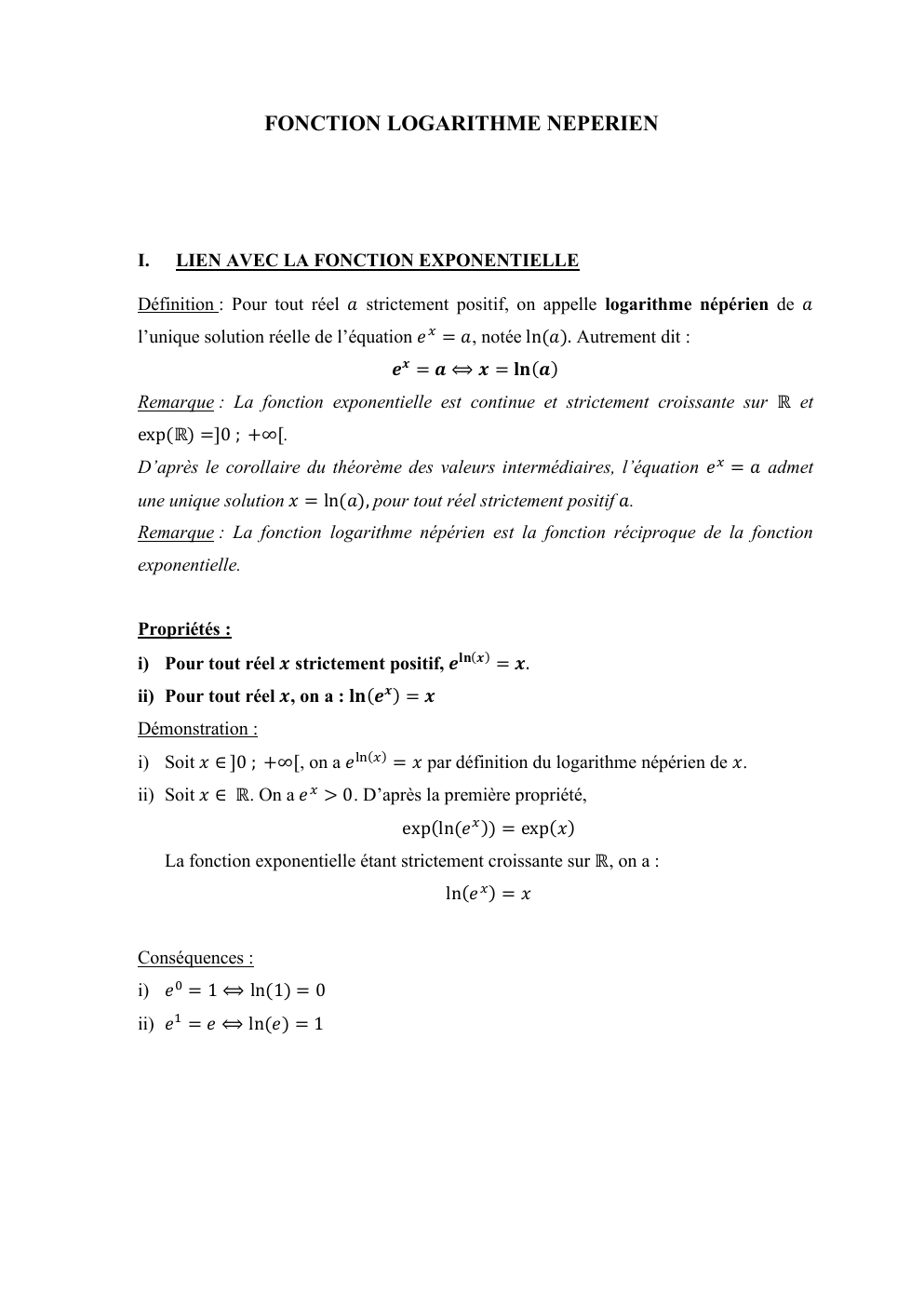FONCTION LOGARITHME NEPERIEN
Publié le 01/05/2025
Extrait du document
«
FONCTION LOGARITHME NEPERIEN
I.
LIEN AVEC LA FONCTION EXPONENTIELLE
Définition : Pour tout réel 𝑎 strictement positif, on appelle logarithme népérien de 𝑎
l’unique solution réelle de l’équation 𝑒 𝑥 = 𝑎, notée ln(𝑎).
Autrement dit :
𝒆𝒙 = 𝒂 ⟺ 𝒙 = 𝐥𝐧(𝒂)
Remarque : La fonction exponentielle est continue et strictement croissante sur ℝ et
exp(ℝ) =]0 ; +∞[.
D’après le corollaire du théorème des valeurs intermédiaires, l’équation 𝑒 𝑥 = 𝑎 admet
une unique solution 𝑥 = ln(𝑎), pour tout réel strictement positif 𝑎.
Remarque : La fonction logarithme népérien est la fonction réciproque de la fonction
exponentielle.
Propriétés :
i) Pour tout réel 𝒙 strictement positif, 𝒆𝐥𝐧(𝒙) = 𝒙.
ii) Pour tout réel 𝒙, on a : 𝐥𝐧(𝒆𝒙 ) = 𝒙
Démonstration :
i) Soit 𝑥 ∈ ]0 ; +∞[, on a 𝑒 ln(𝑥) = 𝑥 par définition du logarithme népérien de 𝑥.
ii) Soit 𝑥 ∈ ℝ.
On a 𝑒 𝑥 > 0.
D’après la première propriété,
exp(ln(𝑒 𝑥 )) = exp(𝑥)
La fonction exponentielle étant strictement croissante sur ℝ, on a :
ln(𝑒 𝑥 ) = 𝑥
Conséquences :
i) 𝑒 0 = 1 ⟺ ln(1) = 0
ii) 𝑒 1 = 𝑒 ⟺ ln(𝑒) = 1
Exemple : Résoudre dans ℝ l’équation 𝑒 7𝑥−3 = 4.
4 > 0 donc l’équation admet une unique solution sur ℝ.
𝑒 7𝑥−3 = 4
⟺ 7𝑥 − 3 = ln (4)
⟺ 7𝑥 =
ln(4) + 3
7
Donc :
ln(4) + 3
}
7
𝑆={
II.
PROPRIETES ALGEBRIQUES
Propriété fondamentale (Relation fonctionnelle) :
Pour tout réels 𝒂 et 𝒃 strictement positifs,
𝐥𝐧(𝒂𝒃) = 𝐥𝐧(𝒂) + 𝐥𝐧(𝒃)
Démonstration : Soient 𝑎 ∈ ℝ∗+ et 𝑏 ∈ ℝ∗+ .
𝑒 ln(𝑎)+ln(𝑏) = 𝑒 ln(𝑎) × 𝑒 ln(𝑏) = 𝑎𝑏 d’après la définition de « ln ».
En passant au logarithme :
𝑒 ln(𝑎)+ln(𝑏) = 𝑎𝑏
⟺ ln( 𝑒 ln(𝑎)+ln(𝑏) ) = ln(𝑎𝑏)
⟺ ln(𝑎) + ln(𝑏) = ln(𝑎𝑏)
Exemple : ln(3 × 5) = ln(3) + ln(5)
Propriété :
Pour tout réel 𝒂 strictement positif,
𝟏
𝐥𝐧 ( ) = −𝐥𝐧(𝒂)
𝒂
Démonstration : Soient 𝑎 ∈ ℝ∗+
1
1
× 𝑎 = 1 ⟹ ln ( × 𝑎) = ln(1)
𝑎
𝑎
D’après la propriété fondamentale,
1
ln ( ) + ln(𝑎) = 0
𝑎
1
⟺ ln ( ) = − ln(𝑎)
𝑎
1
Exemple : ln (2) = −ln(2)
Propriété (Relation fonctionnelle) :
Pour tout réels 𝒂 et 𝒃 strictement positifs,
𝒂
𝐥𝐧 ( ) = 𝐥𝐧(𝒂) − 𝐥𝐧(𝒃)
𝒃
Démonstration : Soient 𝑎 ∈ ℝ∗+ et 𝑏 ∈ ℝ∗+ .
𝑎
1
1
ln ( ) = ln (𝑎 × ) = ln(𝑎) + ln ( )
𝑏
𝑏
𝑏
Donc d’après les propriétés précédemment établies, on a :
𝑎
ln ( ) = ln(𝑎) − ln(𝑏)
𝑏
5
Exemple : ln (8) = ln(5) − ln(8)
Propriété :
Pour tout réel 𝒂 strictement positif, pour tout entier naturel 𝒏,
𝐥𝐧(𝒂𝒏 ) = 𝒏 × 𝐥𝐧(𝒂)
Démonstration : On pose pour 𝑛 ∈ ℕ : 𝑃𝑛 ∶ « ln(𝑎𝑛 ) = 𝑛 × ln(𝑎) , ∀𝑎 ∈ ℝ∗+ ».
Initialisation : ln(𝑎0 ) = ln(1) = 0 et 0 ln(𝑎) = 0
Donc ln(𝑎0 ) = 0 ln(𝑎).
Hérédité : On suppose qu’il existe un entier naturel 𝑛 tel que 𝑃𝑛 est vraie c'est-à-dire :
ln(𝑎𝑛 ) = 𝑛 × ln(𝑎)
Montrons que 𝑃𝑛+1 est vraie, c'est-à-dire :
ln(𝑎𝑛+1 ) = (𝑛 + 1) × ln(𝑎)
ln(𝑎𝑛+1 ) = ln(𝑎𝑛 × 𝑎) = ln(𝑎𝑛 ) + ln(𝑎)
Or par hypothèse de récurrence, ln(𝑎𝑛+1 ) = 𝑛 × ln(𝑎) + ln(𝑎)
Donc ln(𝑎𝑛+1 ) = (𝑛 + 1) ln(𝑎).
Conclusion : 𝑃𝑛 est vraie au rang 0 et 𝑃𝑛+1 est vraie et héréditaire donc vraie pour tout
entier naturel 𝑛.
Exemple : ln(73 ) = 3 ln(7).
Propriété : Pour tout réel 𝒂 strictement positif,
𝐥𝐧(√𝒂) =
𝟏
𝐥𝐧(𝒂)
𝟐
Démonstration : Soit 𝑎 ∈ ℝ∗+ ,
2
(√𝑎) = 𝑎
2
ln ((√𝑎) ) = ln(𝑎) ⟺ 2 ln(√𝑎) = ln(𝑎) ⟺ ln(√𝑎) =
1
ln(𝑎)
2
1
Exemple : ln(√5) = 2 ln(5).
Exemples : Exprimer en fonction de ln(2) et ln (3) les nombres suivants :
2
1
ln(6) ; ln ( ) ; ln ( ) ; ln(√12) ; ln(72)
3
12
i) ln(6) = ln(3 × 2) = ln(3) + ln(2).
2
ii) ln ( ) = ln(2) − ln(3).
3
1
1
iii) ln (12) = ln (2×2×3) = −(ln(2) + ln(2) + ln(3)) = −2 ln(2) − ln(3).
1
1
1
iv) ln(√12) = 2 ln(12) = 2 (ln(2) + ln(2) + ln(3)) = 2 (2 ln(2) + ln(3)).
v) ln(72) = ln(32 × 23 ) = 2 ln(3) + 3 ln(2).
III.
ETUDE DE LA FONCTION LOGARITHME NEPERIEN
A.
Définition
Définition : On appelle fonction logarithme népérien la fonction 𝑓 définie, pour tout 𝑥 ∈
]0 ; +∞[ par 𝑓(𝑥) = ln(𝑥).
La fonction logarithme népérien est continue sur ]0 ; +∞[.
B.
Dérivée
Propriété : Soit 𝒇 la fonction définie sur ]𝟎 ; +∞[ par 𝒇(𝒙) = 𝐥𝐧(𝒙).
𝟏
La fonction 𝒇 est dérivable sur ℝ∗+ et 𝒇′ (𝒙) = 𝒙.
Démonstration : Soit 𝑎 ∈ ℝ∗+ et 𝑥 un réel différent de 𝑎.
𝜏(𝑥) =
ln(𝑥) − ln(𝑎)
𝑥−𝑎
On pose 𝑋 = ln(𝑥) ⟺ 𝑥 = 𝑒 𝑋
𝐴 = ln(𝑎) ⟺ 𝑎 = 𝑒 𝐴
𝑋−𝐴
1
= 𝑋
𝑋
𝐴
𝑒 − 𝑒𝐴
𝑒 −𝑒
𝑋−𝐴
𝜏(𝑥) =
Or ln étant continue en 𝑎, quand 𝑥 → 𝑎, ln(𝑥) ⟶ ln (𝑎) donc 𝑋 ⟶ 𝐴.
lim 𝜏(𝑥) = lim
1
− 𝑒𝐴
𝑋−𝐴
𝑋⟶𝐴 𝑒 𝑋
𝑥⟶𝑎
Or 𝑥 ⟼ 𝑒 𝑥 est dérivable sur ℝ donc en 𝐴.
𝑒𝑋 − 𝑒𝐴
lim
= 𝑒 𝐴 = 𝑒 ln(𝑎) = 𝑎
𝑋⟶𝐴 𝑋 − 𝐴
D’où :
lim 𝜏(𝑥) =
𝑥⟶𝑎
1
𝑎
1
Donc 𝑓 est dérivable en 𝑎 et 𝑓 ′ (𝑎) = 𝑎.
C.
Sens de variation et signe
Propriété : La fonction logarithme népérien est strictement croissante sur ]𝟎 ; +∞[.
1
1
Démonstration : Pour tout réel 𝑥 ∈ ]0 ; +∞[, 𝑓 ′ (𝑥) = 𝑥 et 𝑥 > 0 pour 𝑥 ∈ ]0 ; +∞[ donc 𝑓
est croissante sur ]0 ; +∞[.
Conséquences :
i) Si 𝟎 ≤ 𝒙 ≤ 𝟏, 𝐥𝐧(𝒙) ≤ 𝟎
ii) Si 𝒙 ≥ 𝟏 , 𝐥𝐧(𝒙) ≥ 𝟎
iii) Si 𝒂 ≤ 𝒃, 𝐥𝐧(𝒂) ≤ 𝐥𝐧(𝒃)
iv) 𝐥𝐧(𝒂) = 𝐥𝐧(𝒃) ⟺ 𝒂 = 𝒃
Tableau de signe :
Exemples :
i) Résoudre ln((𝑥 + 3)(𝑥 − 2)) = ln(6) ∶ (𝐸)
Condition : (𝑥 + 3)(𝑥 − 2) = 𝑥² − 2𝑥 + 3𝑥 − 6 = 𝑥² + 𝑥 − 6 > 0.
Δ = 1 − (−24) = 25 > 0 donc on a :
𝑥1 =
−1 − 5
−1 + 5
= −3 ; 𝑥2 =
=2
2
2
Donc 𝐷 =] − ∞ ; −3[ ∪ ]2 ; +∞[.
(𝐸) ⟺ (𝑥 + 3)(𝑥 − 2) = 6
⟺ 𝑥 2 + 𝑥 − 12 = 0
⟺ 𝑥 = 3 ou 𝑥 = −4
{−4 ; 3} ∈ 𝐷 donc 𝑆 = {−4 ; 3}
ii) Résoudre ln(𝑥 + 3) + ln(𝑥 − 2) = ln(6) ∶ (𝐸)
𝐷′ = ] − 3; +∞[ ∩ ]2 ; +∞[ = ]2 ; +∞[
(𝐸) ⟺ ln((𝑥 + 3)(𝑥 − 2)) = ln(6)
⟺ (𝑥 + 3)(𝑥 − 2) = 6
⟺ 𝑥 = 3 ou 𝑥 = −4
Or 𝑥 ∈ 𝐷′ mais −4 ∉ 𝐷′
Donc 𝑆 = {3}.
iii) Résoudre ln((𝑥 + 3)(𝑥 − 2)) ≤ ln(6) ∶ (𝐸)
(𝑥 + 3)(𝑥 − 2) > 0 pour 𝑥 ∈ 𝐷 =] − ∞ ; −3[ ∪ ]2 ; +∞[.
(𝑥 + 3)(𝑥 − 2) ≤ 6 ⟺ 𝑥² + 𝑥 − 12 ≤ 0.
Donc ln((𝑥 + 3)(𝑥 − 2)) ≤ ln(6) pour 𝑥 ∈ [−4 ; 3[ ∪ ]2 ; 3].
Attention : 𝐥𝐧(𝒂𝒃) est défini si 𝒂𝒃 > 0.
𝐥𝐧 (𝒂) + 𝐥𝐧(𝒃) est défini si 𝒂 > 0 et 𝒃 > 0.
On peut toujours écrire 𝐥𝐧(𝒂) + 𝐥𝐧(𝒃) = 𝐥𝐧(𝒂𝒃) mais 𝐥𝐧(𝒂𝒃) = 𝐥𝐧(|𝒂|) + 𝐥𝐧(|𝒃|).
D.
Limites
1.
En +∞
Propriété :
𝐥𝐢𝐦 𝐥𝐧(𝒙) = +∞
𝒙→+∞
Démonstration : Soit 𝐴 > 0
ln(𝑥) > 𝐴 ⟺ 𝑒 ln(𝑥) > 𝑒 𝐴 par croissance de la fonction exponentielle sur ℝ.
On peut rendre ln(𝑥) > 𝐴 à condition que 𝑥 dépasse 𝑒 𝐴 donc :
lim ln(𝑥) = +∞
𝑥→+∞
2.
En 𝟎
Propriété :
𝐥𝐢𝐦 𝐥𝐧(𝒙) = −∞
𝒙→𝟎+
Démonstration : On pose tout réel 𝑥 strictement positif :
𝑋=
1
𝑥
1
ln(𝑥) = ln ( ) = − ln(𝑋)
𝑋
lim ln(𝑥) = lim − ln(𝑋) = −∞
𝑥→0+
𝑥→+∞
Donc on a :
lim ln(𝑥) = −∞
𝑥→0+
E.
Tableau de variations
F.
Courbe
Tangente en 𝐴(1; 0) de coefficient directeur 𝑓 ′ (1) = 1.
1
Tangente en 𝐵(𝑒 ; 1) : 𝑦 ′ = 𝑓 ′ (𝑒)(𝑥 − 𝑒)....
»
↓↓↓ APERÇU DU DOCUMENT ↓↓↓
Liens utiles
- ORAL EN QUOI LES SUITES NUMERIQUES ET LE LOGARITHME NEPERIEN SONT-ILS DES OUTILS POUR MODELISER UN REMBOURSEMENT D’EMPRUNT ?
- La fonction logarithme népérien : propriétés algébriques
- La fonction logarithme népérien : propriétés graphiques
- Logarithme exercice: Préparation DS fonction Ln
- FONCTION PUBLIQUE RÉPARATIONS PÉCUNIAIRES C.E. 7 avr. 1933,.DEBERLES, Rec. 439


